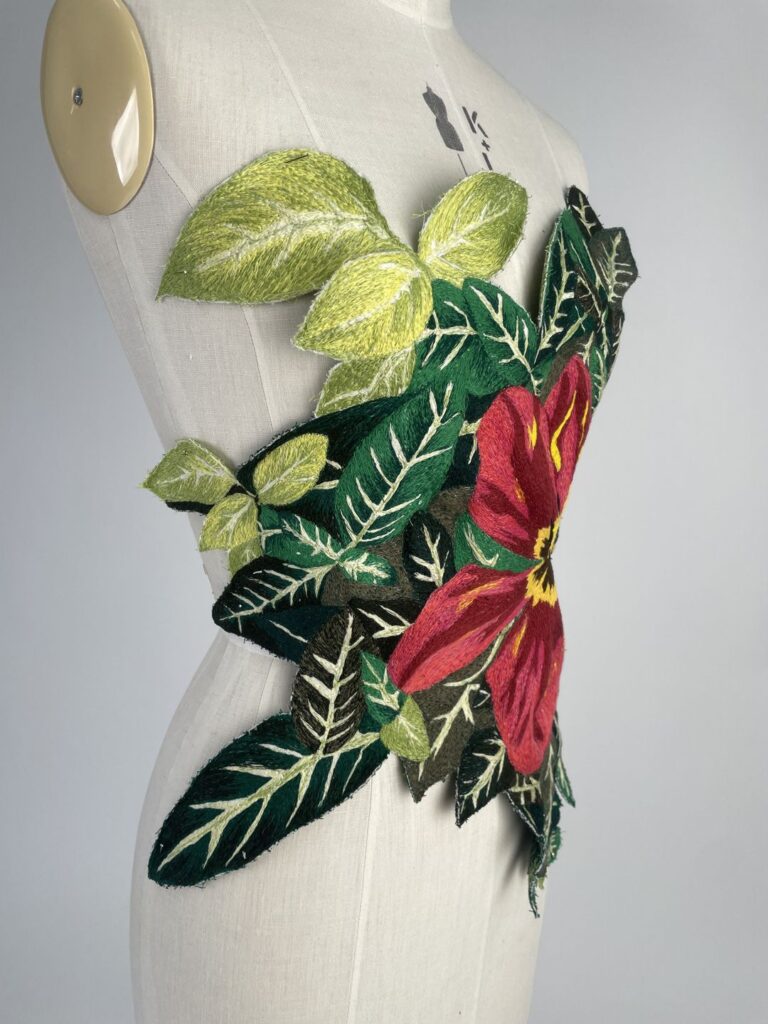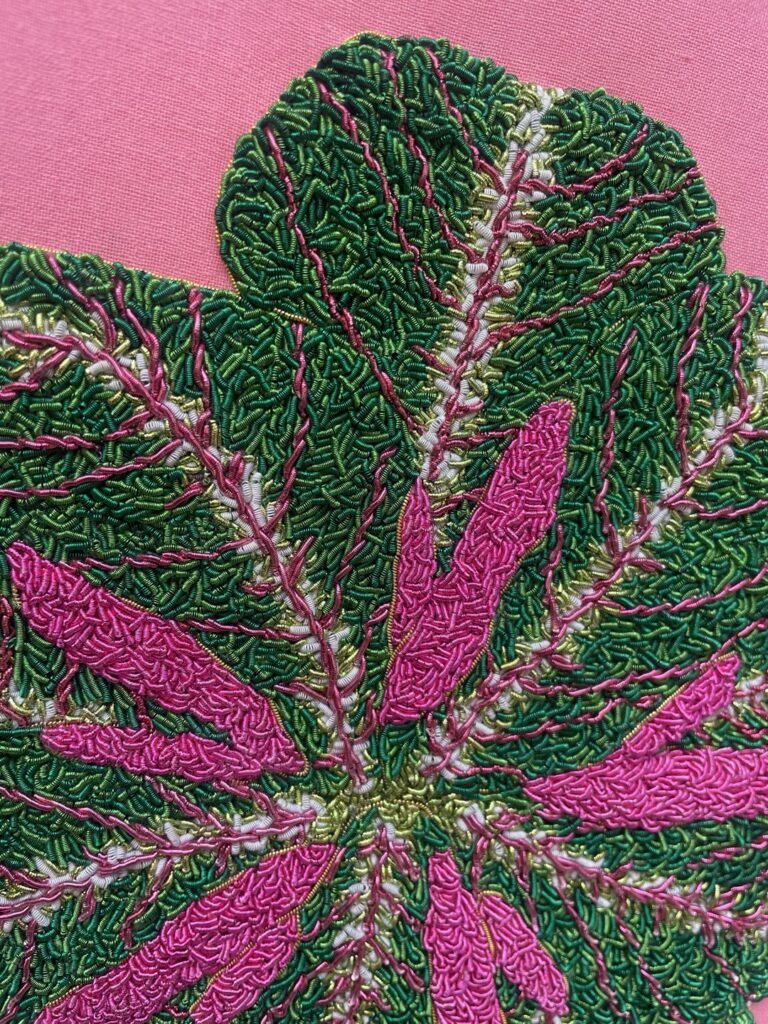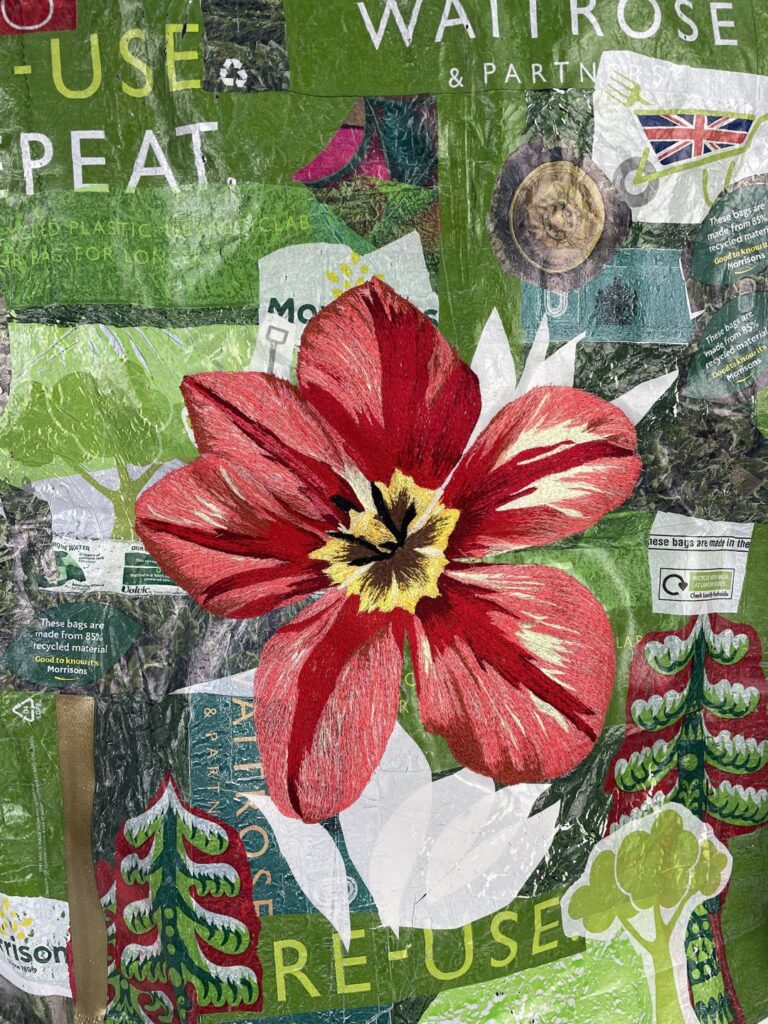
Featured: Detail of ‘Large Flower’
Emily Cox – Guild Graduate in 2025 – celebrates the delicate beauty and structural complexity of the natural world
Biotic celebrates the delicate beauty and structural complexity of the natural world, specifically focusing on leaves and flowers. I drew inspiration from the concept of being ‘Stitched through Nature’ as my body of work explores the organic relationship between textiles and the environment, blending embroidery and natural forms in a way that feels personal and meaningful. I was influenced by visits to Kew Gardens, the Barbican Conservatory and exhibitions at the Saatchi Gallery. Biotic combines high fashion sensibility with a deep respect for nature and artistry. The Project is designed for a luxury market, targeting an audience with an appreciation for one-of-a-kind, hand-crafted embroidery.
Emily Cox 2025
Amelia studied at Buckingham new University. She says:
My work is inspired by the world around me, particularly the beauty found in nature. Visits to galleries such as the Saatchi Gallery, the Barbican, and Kew Gardens, alongside a range of workshops, have influenced the development of my collection. I see embroidery as unique and one-of-a-kind, with every stitch creating something individual. I love using my domestic machine to blend threads and colours, often working sustainably by melting plastic bags to form a base for embroidery. This creates striking, textural surfaces that highlight the possibilities of reusing waste. Alongside this, I have explored goldwork embroidery using materials from Hand & Lock, producing high-end, detailed pieces. My designs reflect natural forms such as flowers and leaves, combining primary imagery I have gathered across Europe into fashion and textile pieces that celebrate both craftsmanship and sustainability. I hope my work encourages people to appreciate the time and care behind handmade pieces while recognising the importance of creating art that respects and protects the natural world.

My first memory of sewing was in primary school, when I made a pillow for a school trip. I went beyond the brief by finding my own fabric and adding a heart-shaped pocket on the front to hold a family photo to take with me,I feel this was sign of how much I loved textiles from the very beginning. Creativity has always run in my family, and I inherited threads and fabrics from my great-grandmother and other relatives. At secondary school, textiles quickly became my favourite subject, thanks to the support of my teacher, Mrs. Heath, who encouraged my ideas and love for making. I was particularly inspired by projects exploring nature, from bark textures to natural patterns, which later shaped my university collection. My biggest supporter has always been my mum, who has shared this journey with me by attending exhibitions and workshops and encouraging me to push forward.
Over time I have learned the importance of patience, resilience, and asking for help. Embroidery takes time, but the results are always rewarding. My approach has always been “all or nothing” once I begin a project, I commit fully, pouring all my time and energy into it. That drive has shaped my practice and helped me create pieces I am proud of.

Studying at Buckinghamshire New University has given me the chance to explore, experiment, and refine my work. I’ve loved the process of developing ideas, researching inspiration, experimenting with drawing and composition, and finally translating them into textiles. Having access to equipment and workshops opened new avenues such as knitting and printing, but my true passion returned when I reconnected with embroidery in third year. With my mum’s encouragement (and her fixing my sewing machine!), I rediscovered my enthusiasm and pushed my embroidery practice to a new level.
An unexpected highlight was writing my dissertation, which I had always found challenging due to dyslexia. With the support of an amazing tutor, Fiona, I found joy in research and achieved a first for my work on the history of embroidery which was something I never thought possible as the writing side of this subject never came naturally to me.
.

To new students, my advice is to dive in and try everything. Explore what excites you, experiment with different techniques, and don’t be afraid to make mistakes. The most rewarding work often comes from moments of play and joy, even amidst the stress of deadlines.

I am especially proud to have developed a body of work that reflects my love for textiles and nature, and to have been given the opportunity to exhibit at the Knit & Stitch Show with the Embroiderers’ Guild, something I am deeply grateful for.

All work featured by Emily Cox
